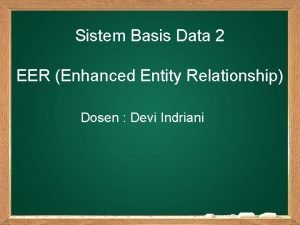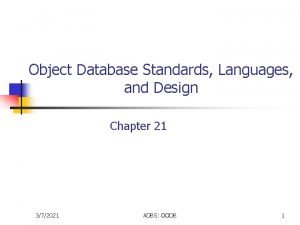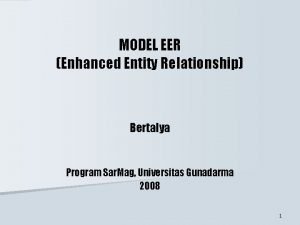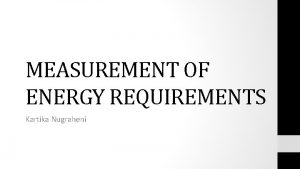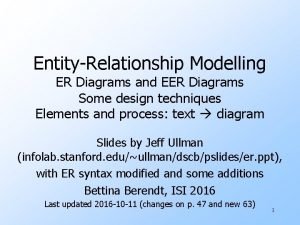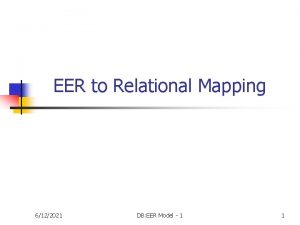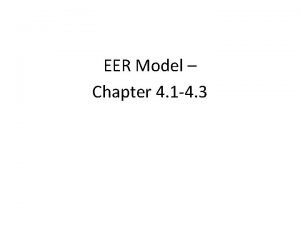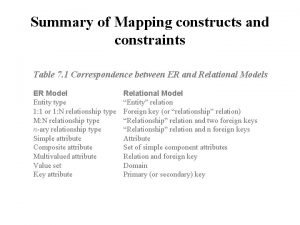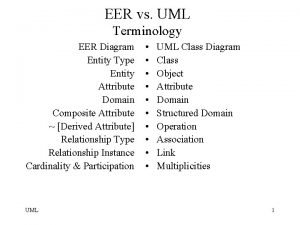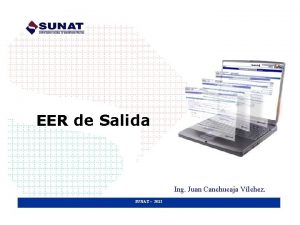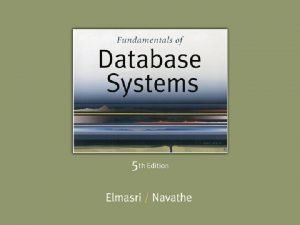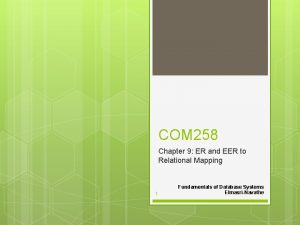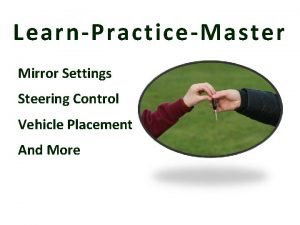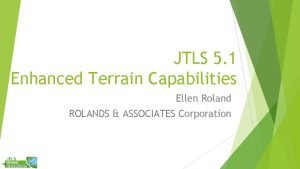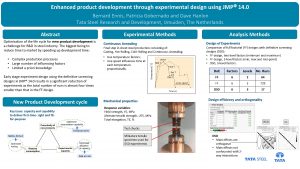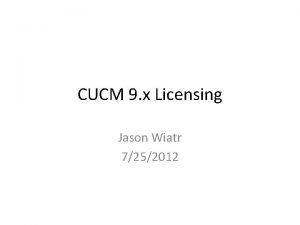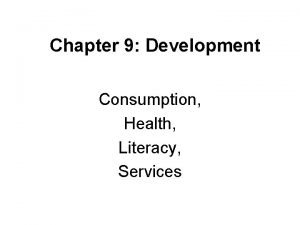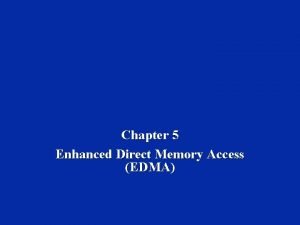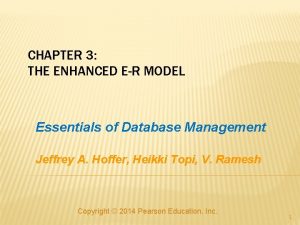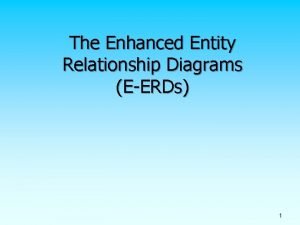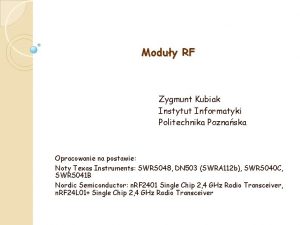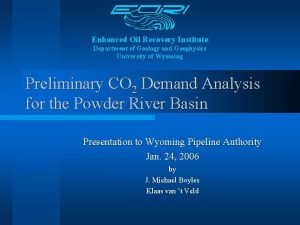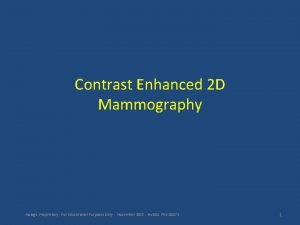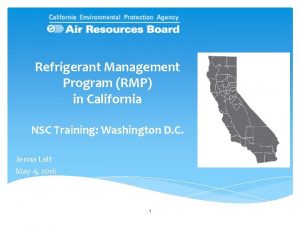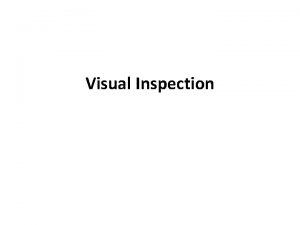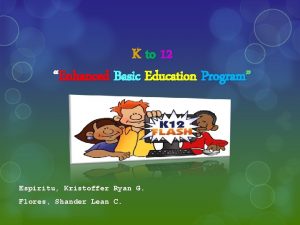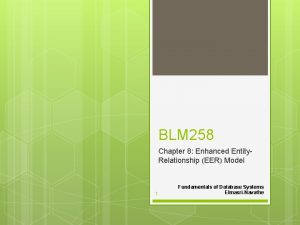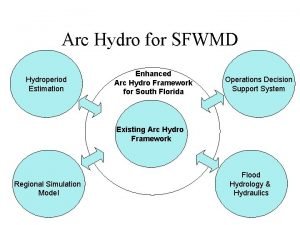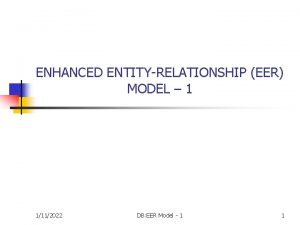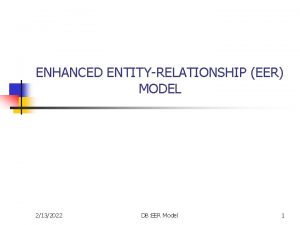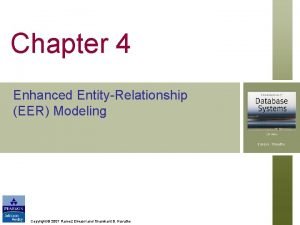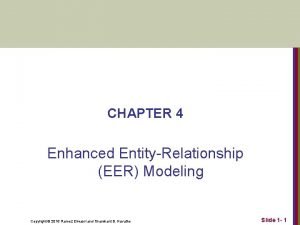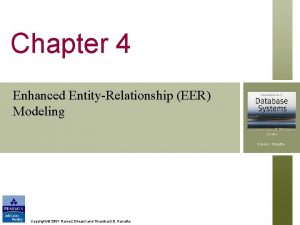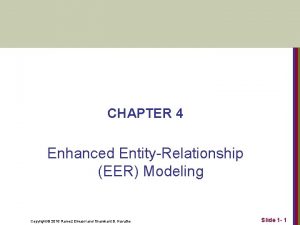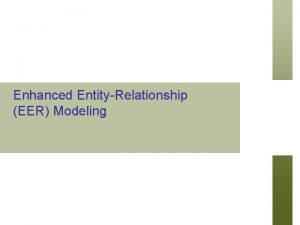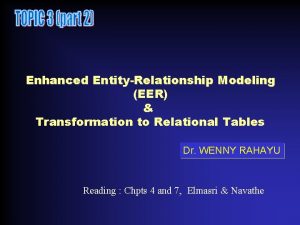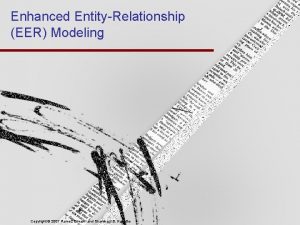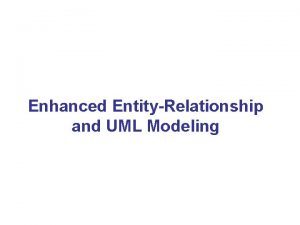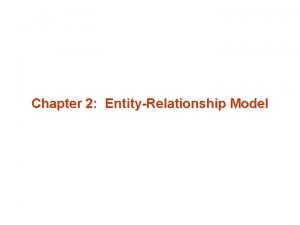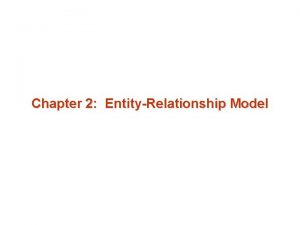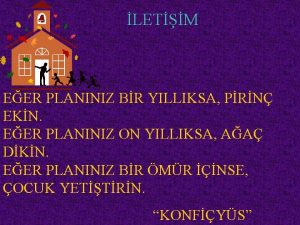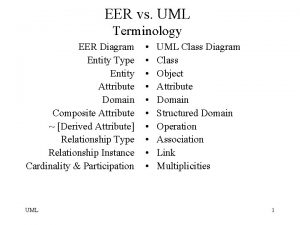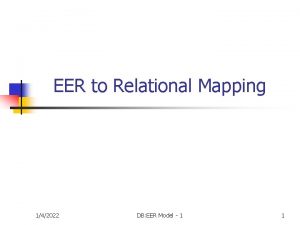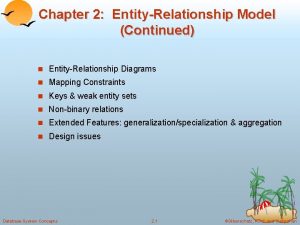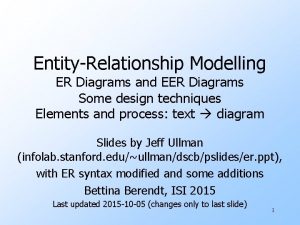Slide 4 1 Chapter 4 Enhanced EntityRelationship EER




























































- Slides: 60

Slide 4 - 1

Chapter 4 Enhanced Entity-Relationship (EER) Modeling

Chapter Outline n n EER stands for Enhanced ER or Extended ER EER Model Concepts n n Includes all modeling concepts of basic ER Additional concepts: n subclasses/superclasses n specialization/generalization n categories (UNION types) n attribute and relationship inheritance These are fundamental to conceptual modeling The additional EER concepts are used to model applications more completely and more accurately n EER includes some object-oriented concepts, such as inheritance Slide 4 - 3

Subclasses and Superclasses Slide 4 - 4

Subclasses and Superclasses (1) n An entity type may have additional meaningful subgroupings of its entities n Example: EMPLOYEE may be further grouped into: n SECRETARY, ENGINEER, TECHNICIAN, … n n MANAGER n n EMPLOYEEs who are managers SALARIED_EMPLOYEE, HOURLY_EMPLOYEE n n Based on the EMPLOYEE’s Job Based on the EMPLOYEE’s method of pay EER diagrams extend ER diagrams to represent these additional subgroupings, called subclasses or subtypes Slide 4 - 5

Subclasses and Superclasses (2) n n Each of these subgroupings is a subset of EMPLOYEE entities Each is called a subclass of EMPLOYEE is the superclass for each of these subclasses These are called superclass/subclass relationships: n n EMPLOYEE/SECRETARY EMPLOYEE/TECHNICIAN EMPLOYEE/MANAGER … Slide 4 - 6

Subclasses and Superclasses (3) n These are also called IS-A relationships n n SECRETARY IS-A EMPLOYEE, TECHNICIAN IS-A EMPLOYEE, …. Note: An entity that is member of a subclass represents the same real-world entity as some member of the superclass: n n n The subclass member is the same entity in a distinct specific role An entity cannot exist in the database merely by being a member of a subclass; it must also be a member of the superclass A member of the superclass can be optionally included as a member of any number of its subclasses Slide 4 - 7

Subclasses and Superclasses (4) n Examples: n A salaried employee who is also an engineer belongs to the two subclasses: n n n A salaried employee who is also an engineering manager belongs to the three subclasses: n n ENGINEER, and SALARIED_EMPLOYEE MANAGER, ENGINEER, and SALARIED_EMPLOYEE It is not necessary that every entity in a superclass be a member of some subclass Slide 4 - 8

Representing Specialization in EER Diagrams Slide 4 - 9

Attribute Inheritance in Superclass / Subclass Relationships n An entity that is member of a subclass inherits n n n All attributes of the entity as a member of the superclass All relationships of the entity as a member of the superclass Example: n n In the previous slide, SECRETARY (as well as TECHNICIAN and ENGINEER) inherit the attributes Name, SSN, …, from EMPLOYEE Every SECRETARY entity will have values for the inherited attributes Slide 4 - 10

Specialization (1) n n Specialization is the process of defining a set of subclasses of a superclass The set of subclasses is based upon some distinguishing characteristics of the entities in the superclass n Example: {SECRETARY, ENGINEER, TECHNICIAN} is a specialization of EMPLOYEE based upon job type. n May have several specializations of the same superclass Slide 4 - 11

Specialization (2) n Example: Another specialization of EMPLOYEE based on method of pay is {SALARIED_EMPLOYEE, HOURLY_EMPLOYEE}. n n Attributes of a subclass are called specific or local attributes. n For example, the attribute Typing. Speed of SECRETARY The subclass can also participate in specific relationship types. n For example, a relationship BELONGS_TO of HOURLY_EMPLOYEE Slide 4 - 12

Specialization (3) Slide 4 - 13

Generalization n n Generalization is the reverse of the specialization process Several classes with common features are generalized into a superclass; n n original classes become its subclasses Example: CAR, TRUCK generalized into VEHICLE; n n n both CAR and TRUCK become subclasses of the superclass VEHICLE. We can view {CAR, TRUCK} as a specialization of VEHICLE Alternatively, we can view VEHICLE as a generalization of CAR and TRUCK Slide 4 - 14

Generalization (2) Slide 4 - 15

Generalization and Specialization (1) n Diagrammatic notation are sometimes used to distinguish between generalization and specialization n n Arrow pointing to the generalized superclass represents a generalization Arrows pointing to the specialized subclasses represent a specialization We do not use this notation because it is often subjective as to which process is more appropriate for a particular situation We advocate not drawing any arrows Slide 4 - 16

Generalization and Specialization (2) n Data Modeling with Specialization and Generalization n n A superclass or subclass represents a collection (or set or grouping) of entities It also represents a particular type of entity Shown in rectangles in EER diagrams (as are entity types) We can call entity types (and their corresponding collections) classes, whether they are entity types, superclasses, or subclasses Slide 4 - 17

Constraints on Specialization and Generalization (1) n If we can determine exactly those entities that will become members of each subclass by a condition, the subclasses are called predicatedefined (or condition-defined) subclasses n n Condition is a constraint that determines subclass members Display a predicate-defined subclass by writing the predicate condition next to the line attaching the subclass to its superclass Slide 4 - 18

Constraints on Specialization and Generalization (2) n If all subclasses in a specialization have membership condition on same attribute of the superclass, specialization is called an attribute-defined specialization n Attribute is called the defining attribute of the specialization Example: Job. Type is the defining attribute of the specialization {SECRETARY, TECHNICIAN, ENGINEER} of EMPLOYEE If no condition determines membership, the subclass is called user-defined n n Membership in a subclass is determined by the database users by applying an operation to add an entity to the subclass Membership in the subclass is specified individually for each entity in the superclass by the user Slide 4 - 19

Displaying an attribute-defined specialization in EER diagrams Slide 4 - 20

Constraints on Specialization and Generalization (3) n Two basic constraints can apply to a specialization/generalization: n n Disjointness Constraint: Completeness Constraint: Slide 4 - 21

Constraints on Specialization and Generalization (4) n Disjointness Constraint: n Specifies that the subclasses of the specialization must be disjoint: n n n Specified by d in EER diagram If not disjoint, specialization is overlapping: n n an entity can be a member of at most one of the subclasses of the specialization that is the same entity may be a member of more than one subclass of the specialization Specified by o in EER diagram Slide 4 - 22

Constraints on Specialization and Generalization (5) n Completeness Constraint: n n Total specifies that every entity in the superclass must be a member of some subclass in the specialization/generalization Shown in EER diagrams by a double line Partial allows an entity not to belong to any of the subclasses Shown in EER diagrams by a single line Slide 4 - 23

Constraints on Specialization and Generalization (6) n Hence, we have four types of specialization/generalization: n n n Disjoint, total Disjoint, partial Overlapping, total Overlapping, partial Note: Generalization usually is total because the superclass is derived from the subclasses. Slide 4 - 24

Example of disjoint partial Specialization Slide 4 - 25

Example of overlapping total Specialization Slide 4 - 26

Specialization/Generalization Hierarchies, Lattices & Shared Subclasses (1) n A subclass may itself have further subclasses specified on it n n n forms a hierarchy or a lattice Hierarchy has a constraint that every subclass has only one superclass (called single inheritance); this is basically a tree structure In a lattice, a subclass can be subclass of more than one superclass (called multiple inheritance) Slide 4 - 27

Shared Subclass “Engineering_Manager” Slide 4 - 28

Specialization/Generalization Hierarchies, Lattices & Shared Subclasses (2) n n n In a lattice or hierarchy, a subclass inherits attributes not only of its direct superclass, but also of all its predecessor superclasses A subclass with more than one superclass is called a shared subclass (multiple inheritance) Can have: n n specialization hierarchies or lattices, or generalization hierarchies or lattices, depending on how they were derived We just use specialization (to stand for the end result of either specialization or generalization) Slide 4 - 29

Specialization/Generalization Hierarchies, Lattices & Shared Subclasses (3) n In specialization, start with an entity type and then define subclasses of the entity type by successive specialization n n In generalization, start with many entity types and generalize those that have common properties n n called a top down conceptual refinement process Called a bottom up conceptual synthesis process In practice, a combination of both processes is usually employed Slide 4 - 30

Categories (UNION TYPES) (1) n n All of the superclass/subclass relationships we have seen thus far have a single superclass A shared subclass is a subclass in: n n n more than one distinct superclass/subclass relationships each relationships has a single superclass shared subclass leads to multiple inheritance In some cases, we need to model a single superclass/subclass relationship with more than one superclass Superclasses can represent different entity types Such a subclass is called a category or UNION TYPE Slide 4 - 31

Categories (UNION TYPES) (2) n Example: In a database for vehicle registration, a vehicle owner can be a PERSON, a BANK (holding a lien on a vehicle) or a COMPANY. n n n A category (UNION type) called OWNER is created to represent a subset of the union of the three superclasses COMPANY, BANK, and PERSON A category member must exist in at least one of its superclasses Difference from shared subclass, which is a: n n subset of the intersection of its superclasses shared subclass member must exist in all of its superclasses Slide 4 - 32

Two categories (UNION types): OWNER, REGISTERED_VEHICLE Slide 4 - 33

Slide 4 - 34

Formal Definitions of EER Model (1) n Class C: n A type of entity with a corresponding set of entities: n n n could be entity type, subclass, superclass, or category Note: The definition of relationship type in ER/EER should have 'entity type' replaced with 'class‘ to allow relationships among classes in general Subclass S is a class whose: n n Type inherits all the attributes and relationship of a class C Set of entities must always be a subset of the set of entities of the other class C n n n S⊆C C is called the superclass of S A superclass/subclass relationship exists between S and C Slide 4 - 35

Formal Definitions of EER Model (2) n Specialization Z: Z = {S 1, S 2, …, Sn} is a set of subclasses with same superclass G; hence, G/Si is a superclass relationship for i = 1, …. , n. n n G is called a generalization of the subclasses {S 1, S 2, …, Sn} Z is total if we always have: n n n Z is disjoint if we always have: n n S 1 ∪ S 2 ∪ … ∪ Sn = G; Otherwise, Z is partial. Si ∩ Sj empty-set for i ≠ j; Otherwise, Z is overlapping. Slide 4 - 36

Formal Definitions of EER Model (3) n Subclass S of C is predicate defined if predicate (condition) p on attributes of C is used to specify membership in S; n n n that is, S = C[p], where C[p] is the set of entities in C that satisfy condition p A subclass not defined by a predicate is called userdefined Attribute-defined specialization: if a predicate A = ci (where A is an attribute of G and ci is a constant value from the domain of A) is used to specify membership in each subclass Si in Z n Note: If ci ≠ cj for i ≠ j, and A is single-valued, then the attribute-defined specialization will be disjoint. Slide 4 - 37

Formal Definitions of EER Model (4) n Category or UNION type T n A class that is a subset of the union of n defining superclasses D 1, D 2, …Dn, n>1: n n n T ⊆ (D 1 ∪ D 2 ∪ … ∪ Dn) Can have a predicate pi on the attributes of Di to specify entities of Di that are members of T. If a predicate is specified on every Di: T = (D 1[p 1] ∪ D 2[p 2] ∪…∪ Dn[pn]) Slide 4 - 38

Alternative diagrammatic notations n n ER/EER diagrams are a specific notation for displaying the concepts of the model diagrammatically DB design tools use many alternative notations for the same or similar concepts One popular alternative notation uses UML class diagrams see next slides for UML class diagrams and other alternative notations Slide 4 - 39

UML Example for Displaying Specialization / Generalization Slide 4 - 40

Alternative Diagrammatic Notations Slide 4 - 41

Slide 4 - 42

EERR-to-Relational Mapping n ER-to-Relational Mapping Algorithm n n n n Step 1: Mapping of Regular Entity Types Step 2: Mapping of Weak Entity Types Step 3: Mapping of Binary 1: 1 Relation Types Step 4: Mapping of Binary 1: N Relationship Types. Step 5: Mapping of Binary M: N Relationship Types. Step 6: Mapping of Multivalued attributes. Step 7: Mapping of N-ary Relationship Types. Mapping EER Model Constructs to Relations n n Step 8: Options for Mapping Specialization or Generalization. Step 9: Mapping of Union Types (Categories). Slide 4 - 43

Mapping EER Model Constructs to Relations (1) n Step 8: Options for Mapping Specialization or Generalization. Convert each specialization with m subclasses {S 1, S 2, …. , Sm} and generalized superclass C, where the attributes of C are {k, a 1, …an} and k is the (primary) key, into relational schemas using one of the four following options: Slide 4 - 44

Mapping EER Model Constructs to Relations (2) n Option 8 A: Multiple relations-Superclass and subclasses. n Create a relation L for C with attributes Attrs(L) = {k, a 1, …an} and PK(L) = k. n Create a relation Li for each subclass Si, 1 < i < m, with the attributes Attrs(Li) = {k} U {attributes of Si} and PK(Li)=k. n This option works for any specialization (total or partial, disjoint or over-lapping). Slide 4 - 45

FIGURE 4. 4 EER diagram notation for an attribute-defined specialization on Job. Type. Slide 4 - 46

FIGURE 7. 4 Options for mapping specialization or generalization. (a) Mapping the EER schema in Figure 4. 4 using option 8 A. Slide 4 - 47

Mapping EER Model Constructs to Relations (3) n Option 8 B: Multiple relations-Subclass relations only n Create a relation Li for each subclass Si, 1 < i < m, with the attributes Attr(Li) = {attributes of Si} U {k, a 1…, an} and PK(Li) = k. n This option only works for a specialization whose subclasses are total n (every entity in the superclass must belong to (at least) one of the subclasses). Slide 4 - 48

FIGURE 4. 3 Generalization. (b) Generalizing CAR and TRUCK into the superclass VEHICLE. Slide 4 - 49

FIGURE 7. 4 Options for mapping specialization or generalization. (b) Mapping the EER schema in Figure 4. 3 b using option 8 B. Slide 4 - 50

Mapping EER Model Constructs to Relations (contd. ) (1) n Option 8 C: Single relation with one type attribute n Create a single relation L with attributes Attrs(L) = {k, a 1, …an} U {attributes of S 1} U…U {attributes of Sm} U {t} and PK(L) = k. n The attribute t is called a type (or discriminating) attribute that indicates the subclass to which each tuple belongs Slide 4 - 51

FIGURE 4. 4 EER diagram notation for an attribute-defined specialization on Job. Type. Slide 4 - 52

FIGURE 7. 4 Options for mapping specialization or generalization. (c) Mapping the EER schema in Figure 4. 4 using option 8 C. Slide 4 - 53

Mapping EER Model Constructs to Relations (contd. ) (2) n Option 8 D: Single relation with multiple type attributes n Create a single relation schema L with attributes Attrs(L) = {k, a 1, …an} U {attributes of S 1} U…U {attributes of Sm} U {t 1, t 2, …, tm} and PK(L) = k. n Each ti, 1 < I < m, is a Boolean type attribute indicating whether a tuple belongs to the subclass Si. Slide 4 - 54

FIGURE 4. 5 EER diagram notation for an overlapping (non-disjoint) specialization. Slide 4 - 55

FIGURE 7. 4 Options for mapping specialization or generalization. (d) Mapping Figure 4. 5 using option 8 D with Boolean type fields Mflag and Pflag. Slide 4 - 56

Mapping EER Model Constructs to Relations (contd. ) n Mapping of Shared Subclasses (Multiple Inheritance) n n n A shared subclass, is a subclass of several classes, indicating multiple inheritance. These classes must all have the same key attribute; otherwise, the shared subclass would be modeled as a category. We can apply any of the options discussed in Step 8 to a shared subclass. Slide 4 - 57

Mapping EER Model Constructs to Relations (contd. ) n Step 9: Mapping of Union Types (Categories): n n For mapping a category whose defining superclass have different keys, it is customary to specify a new key attribute, called a surrogate key, when creating a relation to correspond to the category. In the example below we can create a relation OWNER to correspond to the OWNER category and include any attributes of the category in this relation. The primary key of the OWNER relation is the surrogate key, which we called Owner. Id. Slide 4 - 58

FIGURE 4. 8 Two categories (union types): OWNER and REGISTERED_VEHICLE. Slide 4 - 59

FIGURE 7. 6 Mapping the EER categories (union types) in Figure 4. 7 to relations. Slide 4 - 60
 Basic dance steps in heel and toe polka
Basic dance steps in heel and toe polka Factoring polynomials
Factoring polynomials Seer vs ieer
Seer vs ieer Maksud dari shared-subclass pada model erd adalah
Maksud dari shared-subclass pada model erd adalah Mapping an eer schema to an odb schema
Mapping an eer schema to an odb schema Canada's old food guide
Canada's old food guide N1 pada gambar eer sebaiknya diisi
N1 pada gambar eer sebaiknya diisi Contoh erd generalisasi
Contoh erd generalisasi Rumus bee laki-laki
Rumus bee laki-laki Eer diagram
Eer diagram Eer vs erd
Eer vs erd Eer
Eer Rumus eer anak
Rumus eer anak Union in er diagram
Union in er diagram Eer
Eer Erd vs uml
Erd vs uml Manifiesto eer
Manifiesto eer Manifiesto eer
Manifiesto eer Eer modell
Eer modell Er and eer
Er and eer Llw cisco
Llw cisco Mail
Mail National programme on technology enhanced learning
National programme on technology enhanced learning Programa ng pamahalaan para sa mamamayan
Programa ng pamahalaan para sa mamamayan Enhanced mirror setting
Enhanced mirror setting Enhanced terrain layer
Enhanced terrain layer Enhanced product development
Enhanced product development How eigrp works
How eigrp works Cucm enhanced license
Cucm enhanced license What is cpesn
What is cpesn What does alice training mean
What does alice training mean Buried in barstow enhanced edition
Buried in barstow enhanced edition Enhanced dicom
Enhanced dicom Enhanced greenhouse effect
Enhanced greenhouse effect Enhanced direct memory access
Enhanced direct memory access Overlapping subtype example
Overlapping subtype example Erd supertype subtype
Erd supertype subtype Enhanced shockburst
Enhanced shockburst Enhanced primary care mental health
Enhanced primary care mental health Enhanced oil recovery institute
Enhanced oil recovery institute Readiness for enhanced spiritual well-being
Readiness for enhanced spiritual well-being Enhanced security administrative environment
Enhanced security administrative environment Hologic contrast enhanced mammography
Hologic contrast enhanced mammography Enhanced disability management program
Enhanced disability management program California refrigerant management program
California refrigerant management program Enhanced health in care homes
Enhanced health in care homes E-marketing enhanced product development
E-marketing enhanced product development E-marketing enhanced product development
E-marketing enhanced product development Enhanced healthcare solutions
Enhanced healthcare solutions Computer enhanced visual inspection system
Computer enhanced visual inspection system Technology enhanced items
Technology enhanced items Diagram of qwerty keyboard
Diagram of qwerty keyboard Enhanced basic education act of 2013
Enhanced basic education act of 2013 Enhanced core reading instruction
Enhanced core reading instruction Enhanced greenhouse effect
Enhanced greenhouse effect Improved howland current source
Improved howland current source Cdphp enhanced primary care
Cdphp enhanced primary care Enhanced platform awareness
Enhanced platform awareness Enhanced entity relationship
Enhanced entity relationship Gr hydro north
Gr hydro north Slide to doc.com
Slide to doc.com



